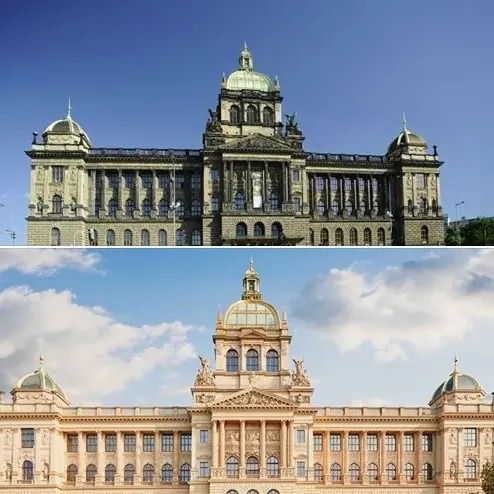It's really important to me when I can write about something that's interesting to me. And the National Museum really is. When I was little I visited it with my grandparents who told me of the artifacts I had once seen. When you are children and you see something you have never seen before, you are blown away and that's how you feel when you're here. Now, the National museum interests me but in a different way.
Even though I didn't like that one of my favorite Prague buildings had to be closed a few years ago, I can see today that the repairs were really necessary. Unfortunately, it was not possible to finish it before the 100th anniversary of the Republic.
Immediately after the opening, I went to the museum to take photos of the building from inside and outside and write a long blog about it. But our plan was overridden by the planned completion of the interior. Today, therefore, the article will cover mainly the exterior of the National Museum, history and rebuilding. In the second part of this blog, I will focus on the interior. The museum opens again in early March which I'm really looking forward to.
I would like to divide this article into 3 subchapters. Unfortunately, I don't remember as much information to describe the history of the building in detail. That's why I decided to use the site of the National Museum. I found data and important events here. Along with what I know and what I read, here is a brief overview of history.
It all started in 1840 when František Palacký (you can read something about him in the last article) made a proposal to create a new building that would serve as a center of science and culture. The name would be Francisceum (a tribute to Emperor Franz I). He wanted to create a place where people could see collections of different themes, such as geology, mineralogy, zoology, botany, archeology … and much more. This construction didn't happen at this time, but after half a century, Josef Schulz made it happen.
In 1844, one museum was built - Nostic Palace on Na Příkopě street (now demolished). The site was quickly filled with new and new collections and soon there was no more space. That's why the idea of building a new building has become more and more real. The new building needed a new place, a large parcel that was hard to find at that time. The developers wanted first place next to the New Town Hall. Counselors didn't like this idea though. After many discussion later, which lasted for years, in 1876 the city council decided to donate a favorable land on top of Wenceslas Square. In 1883, a tender was announced and the architect Josef Schulz won.
When the construction was permitted in 1885, the building quickly began to rise. The construction started with the basement. In the following year, it reached its crown cornices and began to build vaults. It was followed by a balustrade, a roof, a tympanum. The balustrade was later supplemented by sculptures. The construction lasted for several years and in 1891, the Museum of the Kingdom of Bohemia was officially opened.
Soon after, the building was heavily damaged by three events. The first was the German occupation during World War II when a bomb was thrown at the museum in 1945, which damaged part of the zoological collections. These collections and, for example, Pantheon statues have been hidden in various places. After the occupation, they should've been returned again. Some of the sculptures, however, replaced others, due to the reorganization of the former Minister of Culture.
The second event was the occupation of Czechoslovakia in 1968 by the Warsaw Pact armies. Soviet soldiers intentionally shot on the building and destroyed plaster, sculptures, and reliefs. Until today we can see marks of the shooting on the facade.
In 1978-1989 the expositions of the museum were placed on the Victory February Square. The most threatening for the building was the construction of the metro and the Northwest Magistral, thanks to which the Museum was struggling with vibrations, dustiness, and noise. Later, the expositions moved to Wenceslas Square again.
From 2011 to October 2018, the main building was closed for reconstruction. The building was partially opened on the 100th anniversary of Czechoslovakia and the 200th anniversary of the establishment of the National Museum. In addition to the overall repairs to the exterior and interior of the building, a courtyard was roofed, a viewing dome was opened and a connecting tunnel built into the former Federal Assembly building.
From our external collaborator Tereza Kultová